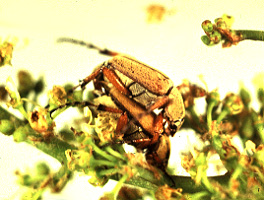
Rose chafer, Macrodactylus subspinosus
(Fabricius)
This general feeder is related to the Japanese
beetle and the life cycle is similar. Rose chafer was first
reported
as a grape pest as early as 1810, later extending its host range to
include
a wide assortment of host plants. Grape remains among the most severely
injured crops. Larvae overwinter in soil, resuming development in the
spring.
Adults emerge in late May or early June, near the time of grape bloom.
These are tan, long-legged beetles about 12 mm long. Mating and egg
laying
occur continuously for about two weeks with each female depositing 24
to
36 eggs. The average life span of the adult is about three weeks, when
they feed on blossoms, newly set fruit and leaves. In about two weeks,
eggs hatch and larvae begin feeding on grass roots. This pest is more
common
in areas with light sandy soils. There is one generation per year.
Control is seldom needed for this pest, but
vigilance
should be maintained early in the season in case of high numbers. In
severe
cases, blossom buds are often completely destroyed, resulting in little
or no grape production. Population levels vary from year to year.
Petal-fall
sprays for grape berry moth will also control rose chafers.
This is taken primarily from an extension
bulletin
by D. G. Pfeiffer & P. B. Schultz, entitled "Major Insect and Mite
Pests of Grape in Virginia" (Va. Coop. Ext. Serv. 444-567 (1986))
See NCSU factsheet,
and
photo
by Jeff Hahn.
Back to Virginia
Vineyard
page
Back to Virginia
Fruit Page